The general consensus seems to be “I like Anatomy of a Game, but Kid Icarus is dumb.” So let’s just power on through the rest of this bad boy today and tomorrow and move along to more fertile territory, shall we?
Really, there’s not too much to break down about most of the second half of Kid Icarus. Like I said, the game shows its hand early, and once you’ve met Eggplant Wizards and Pluton, there’s nothing else so aggressively weird or spiteful to be found. World 2-4 is of course a fortress world, one more complex in layout than World 1-4, but definitely not insurmountable. The free-form navigation of the stage and the persistence of certain stats when you die and continue (such as cash) means you can farm all the goodies you like here, if you really want. Unlike Metroid, Kid Icarus doesn’t factor time spent mucking around in the world in determining the ending you see, so there’s honestly no downside to chilling out and stocking up on goodies.
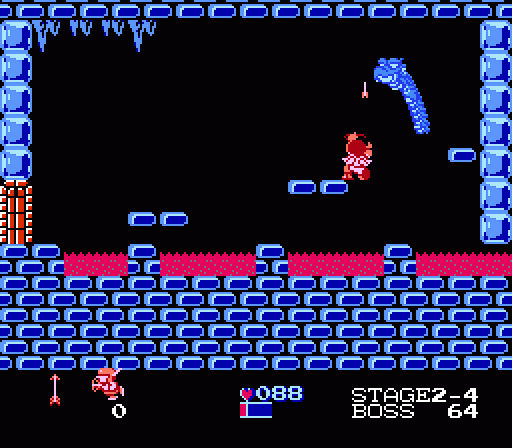
The second boss of the game is Hewdraw, another famous critter of Greek mythology whose name ended up being mangled in translation from Greek to Japanese to English. It’s the Hydra, basically, though with a slightly elongated first syllable that… well, it doesn’t matter. Hewdraw is the Hydra. But with one head. It bounces around the room in a fairly predictable pattern and is easy enough to take down, though only its head is vulnerable. This serpent style of enemy would appear in many subsequent NES games, including two that have already been explored in Anatomy of a Game: Zelda II and Castlevania III.
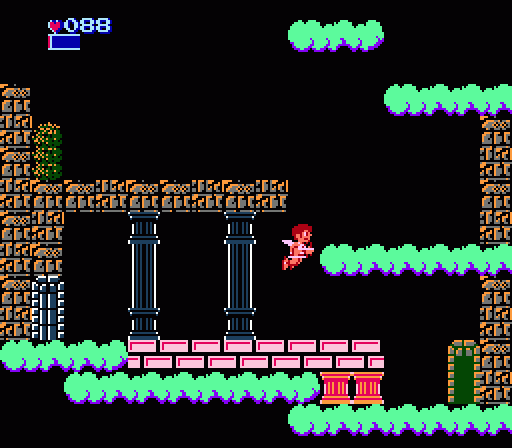
The appearance of a fortress world precipitates another change in play format, this time going from horizontal back to vertical. Pit has escaped the Underworld, traversed the surface, and now he rises through Skyworld to Palutena’s temple where Medusa has taken control. It’s a pretty neat touch of progression that parallels what Konami was doing with Castlevania at the time, though the effect is somewhat muted by the time of day change. Since World 2-3 went from daytime to night, you enter Skyworld in darkness, which makes it look basically indistinct from the Underworld. The 3D Classics Kid Icarus remake is much better about this and adds a few small details to give a better sense of ascending through the sky, but here you’ll just have to take the clouds platforms’ word for it.
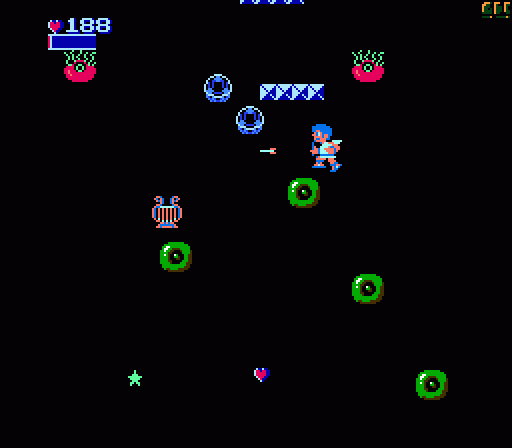
Worlds 3-1 through 3-3 play much like Worlds 1-1 through 1-3. But anyone with the tenacity and skill to survive the Underworld will find the Skyworld laughably simple. These later stages do very little to build on the challenges of the earlier worlds — though some of the teeny-tiny platforms you face are far more easily negotiated with the modified jumping style of the 3D Classics version — and since you’ll almost certainly have considerably more health and strength here, you can more or less tear through foes. Chances are good you have a number of items stocked up, too; Feathers will prevent falling deaths, Water of Life will restore your health, and the rare but essential Barrel will let you store up to eight Waters of Life. It’s entirely possible to be fully powered-up by the end of World 3-3, and once you’ve reached that point the entire world of Kid Icarus may as well be wet tissue paper for you to tear through.
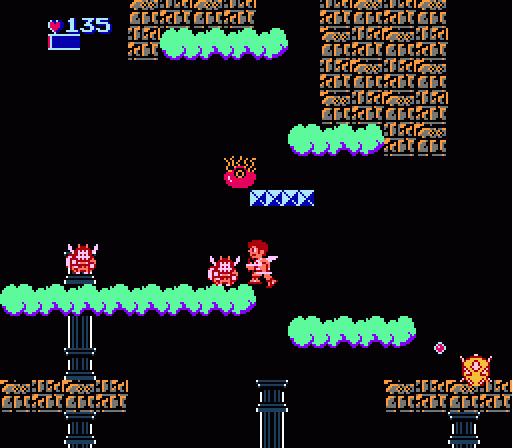
The Skyworld features two new enemies of note. While most foes here are essentially just reskins of monsters you’ve faced before, there’s an important new variant. Namely, Pluton Flies, which are smaller, faster variants on Pluton. The flying version sits at the edge of the screen until you pass its line of sight, at which point it zips into action and flies straight across the screen in an attempt to swipe your goods. The advantage you have here versus in the Overworld is that a Pluton Fly moves more predictably — literally in a straight line — and a single shot will take them down. Again, Kid Icarus‘ threats are mostly front-loaded, and the game gets easier the longer you play.
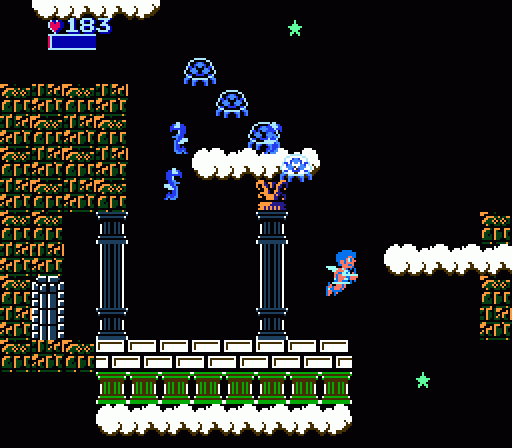
Secondly, there’s a new flying enemy, Komayto, that behaves just like Monoeyes. But they look like Metroids! They go down a lot easier than Metroids do, but the resemblance is remarked on even in the instruction manual. The Japanese name for these creatures, Kometo, makes the connection even clearer — “meto” is the first two syllables of the Japanese name for Metroids (metoroido), and the ko- prefix usually means small; a kitten, for example, is a koneko, a small (ko-) cat (-neko). So basically, these are Metroid hatchlings. Can you imagine how different things would have been if Pit had let them imprint on him rather than just shooting them out of the air?
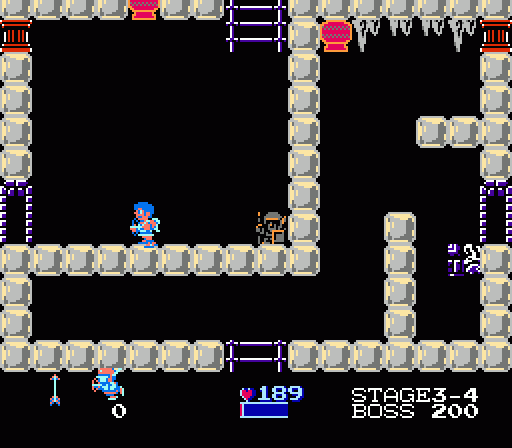
And finally, the Skyworld ends with the game’s third fortress. This is by far the biggest and most complex area of the game, as difficult in its own way as the early stages. The challenge here stems not from devious monsters (the Eggplant Wizards aren’t as cheaply placed as in that first fortress) or deadly traps but rather from the size of the fortress and the winding route to the boss. This stage makes full use of what appears to be the maximum size available to the dungeons — it consists of an 8×8 grid of screens, and all 64 room spaces contain something. It’s roughly the size of the first two fortresses combined, and you almost certainly need to map your route — not just to the exit, but to the healing hot springs, the eggplant clinic, and the shops as well.
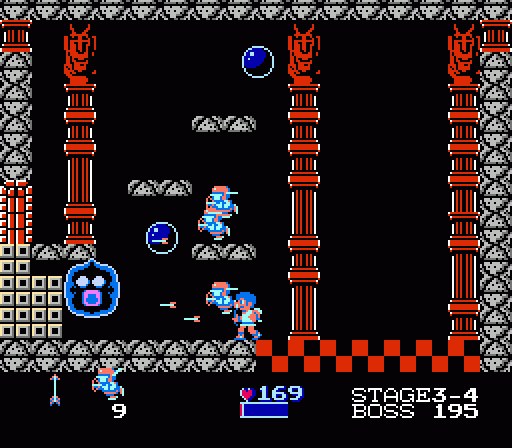
The boss, Pandora, turns out to be surprisingly unthreatening after all of that. It wobbles slowly around the room, occasionally becoming invulnerable, the only real threat posed by its two indestructible companion blobs that vaguely home in on Pit while blocking his shots. Pandora’s auxiliary bits are murder on any little centurions you happen to bring into the battle, but otherwise there’s very little challenge here for a Pit powered up sufficiently to take on the final stage.
World 3 goes back to the Pit of Eaten Screen Memory, but unlike World 1 you’re much more prepared. Chances are good you’ll have four or five life bars and a few arrow upgrades by that point. As for the bosses, Hewdraw and Pandora feel more like tech pieces, the former being a multi-sprite monster and the latter periodically turning transparent.
Maybe it’s because I played through Alex Kidd in Miracle World last year (SEGA Vintage Collection, because save states), but one thing I noticed about Kid Icarus while replaying it is that it and Kid Icarus feel similar in a few ways, less like one ripping off the other and more like a case of convergent evolution. Both feature protagonists navigating worlds with ratchet scrolling, both are platformers featuring money/inventory/shops, both have gameplay shifts (Alex Kidd’s vehicles, Kid Icarus’s shooter segment at the end) and both have dungeon stages where the games become more like a platformy Zelda.
Of course, Kid Icarus is way more forgiving than Alex Kidd, so…
Jeremy,
I actually love Kid Icarus and have been looking forward to these. I recognize that it’s largely nostalgia-fueled, but the willingness to really mix it up into such different gameplay types was very appealing to me.
Kid Icarus I also felt really gave you a sense of progression and power (if you ever made it past 1-3). You really felt more capable and much stronger as the game went on, to where it was relatively easy at the end.
Thank you for digging into this one, as this was an Anatomy series that I wanted to most see after Castlevania, Zelda, and Metroid. I never comment, but wanted to let you know I’m reading.
I like Anatomy of a Game, and Kid Icarus is pretty ok. That said, it’s definitely influential, and I think understanding its design is important, especially in terms of how it relates to what came after it.
I dunno if “Kid Icarus is dumb” is how I feel about the matter. It’s more a case of “I find it difficult to engage with Kid Icarus because I never got past the initial gauntlet,” I still think it’s important in the evolution of games and certifiably better than the near unplayable garbage that makes up ~80% of the NES’ library.
I feel silly because I didn’t realize the link to the SMB anatomy books was a stuck link, so I missed the past few Icarus updates. I’d also like to chime in and say while Kid Icarus is probably one of the less exciting/ground-breaking games to be featured, I’ve enjoyed reading these articles because more so than any of the others, it’s an anatomy on why a particular type of design didn’t work and create a game that people still fondly re-play and love.
The initial levels were definitely worth the in-depth study, just because it’s such a bizarrely backwardly structured game. Reading your articles on Icarus, along with the ones on SMB and Metroid, you can really see why certain elements just fit together perfectly in those games and why the combinations in Icarus just didn’t cohere into a very fair or fun game. I’m looking forward to the final article on this game, as I think it’s the first time you’ve broken down a shoot-em-up type level in a game (even though it’s not a good or challenging one).
Thanks again for your work!
Was traffic good for Super Mario Bros? Honestly, you have to know the game VERY well for these articles to be interesting.
There’s probably a limited number that would garner good traffic: Mario 2-3 and World and maybe 64, Mega Man 2-3, Link to the Past and Ocarina of Time, Super Metroid, Symphony of the Night, maybe Chrono Trigger…
You might also want to review a few of the best levels, the stuff which makes each game stand out, rather than covering every part of a game. Even SMB dragged a bit in the middle.
I’ve enjoyed all of these Anatomies, including the Kid Icarus ones, although — yeah — lack of familiarity with the source material has dampened my enthusiasm somewhat. I’m looking at the screenshots and saying, huh, I guess THAT’S in the game, who knew? It’s certainly not a matter of the articles being badly written — it’s just that they’re not providing a fresh perspective on a game I’ve already got a lot of nostalgia for.
I’d be very interested in an Anatomy of Mario 2.
I’ve enjoyed these, though this last batch of three I’m only getting to all at once because I’ve been busy. But I never got too far in, so seeing it this way is pretty cool.
Funny, I thought Kid Icarus was one of the most heavily-requested titles? Too bad it’s not doing so well here, I was hoping we might get further comparing and contrasting in the siblings’ Game Boy sequels, Return of Samus and Of Myths and Monsters… not only between each other, but their prequels as well, and see which one came out ahead in terms of evolution.
Hey, count me in as another fan of both Anatomy AND this Kid Icarus write-up. In fact if anything I’ve been enjoying this series more (so I’m moderately bummed when I glance at the top of this one and see that you’re blitzing through to the end). I think it may be because, as insightful and entertaining as your Mario Anatomies are, there’s this kind of “well, everybody’s written about Super Mario” sense. Whereas not nearly as many are writing about Kid Icarus, and practically nobody at this level of detail.
But I understand that a lot less people are familiar with Icarus, so it’s that old conflict between die-hard niche audience vs casual mass audience… and a site hit is a site hit, enthusiasm or not. I’ve had smaller-scale problems with the readership of my own site… which, I admit with some sheepishness, is at least partially inspired by Anatomy of a Game.